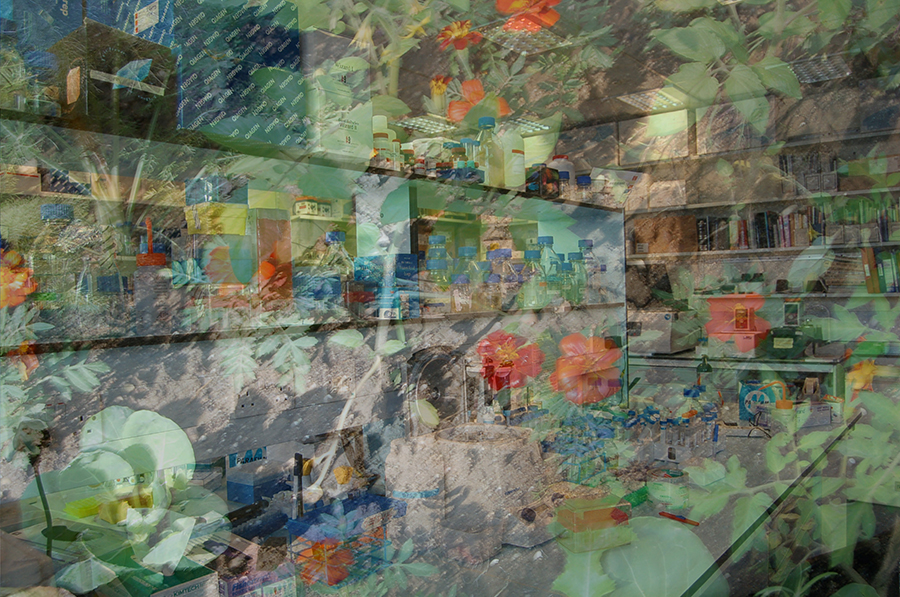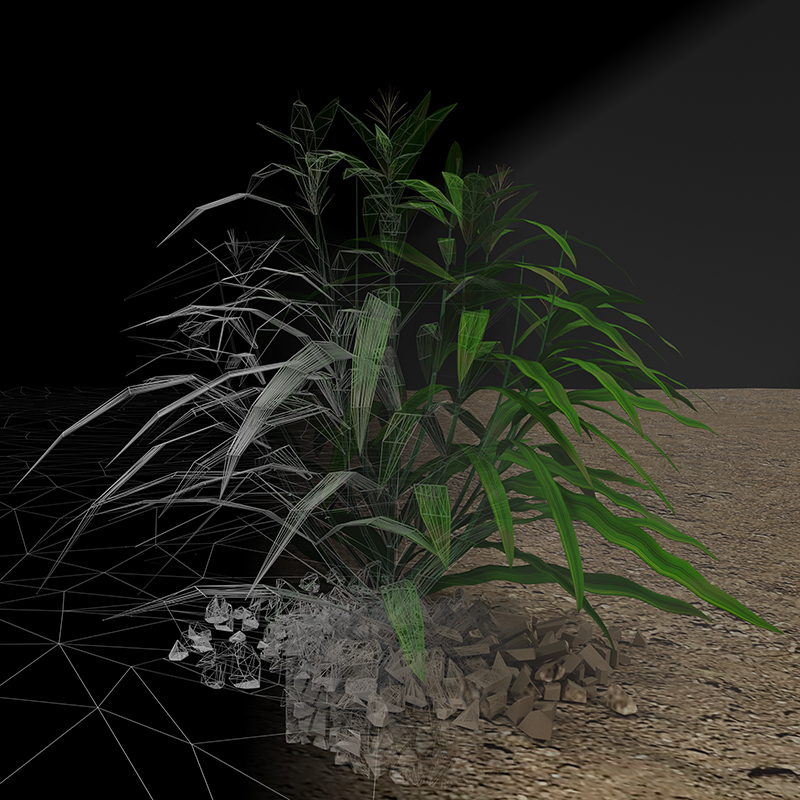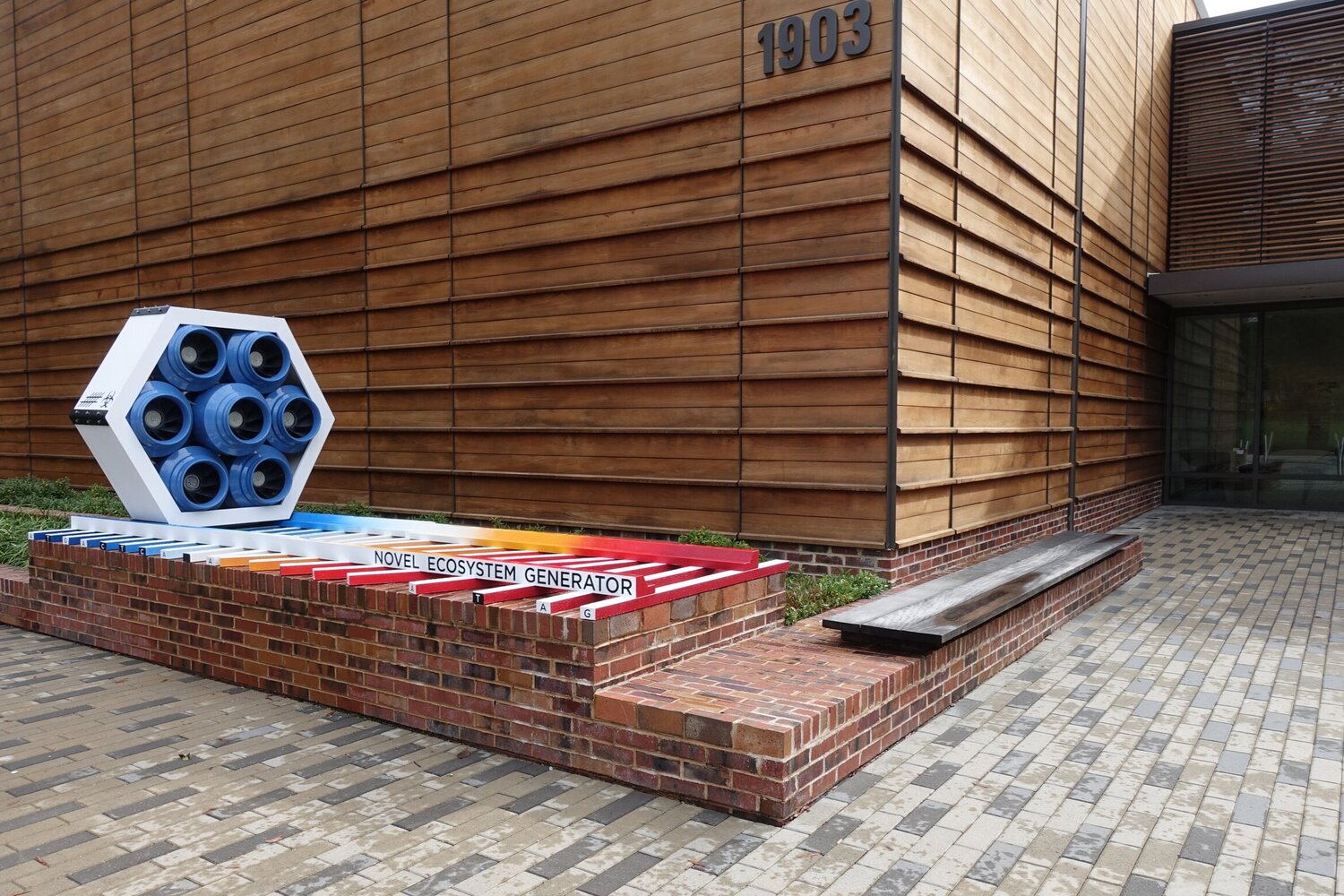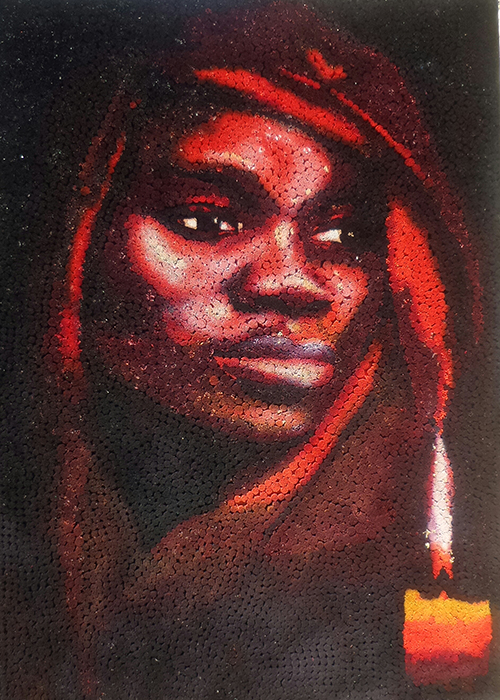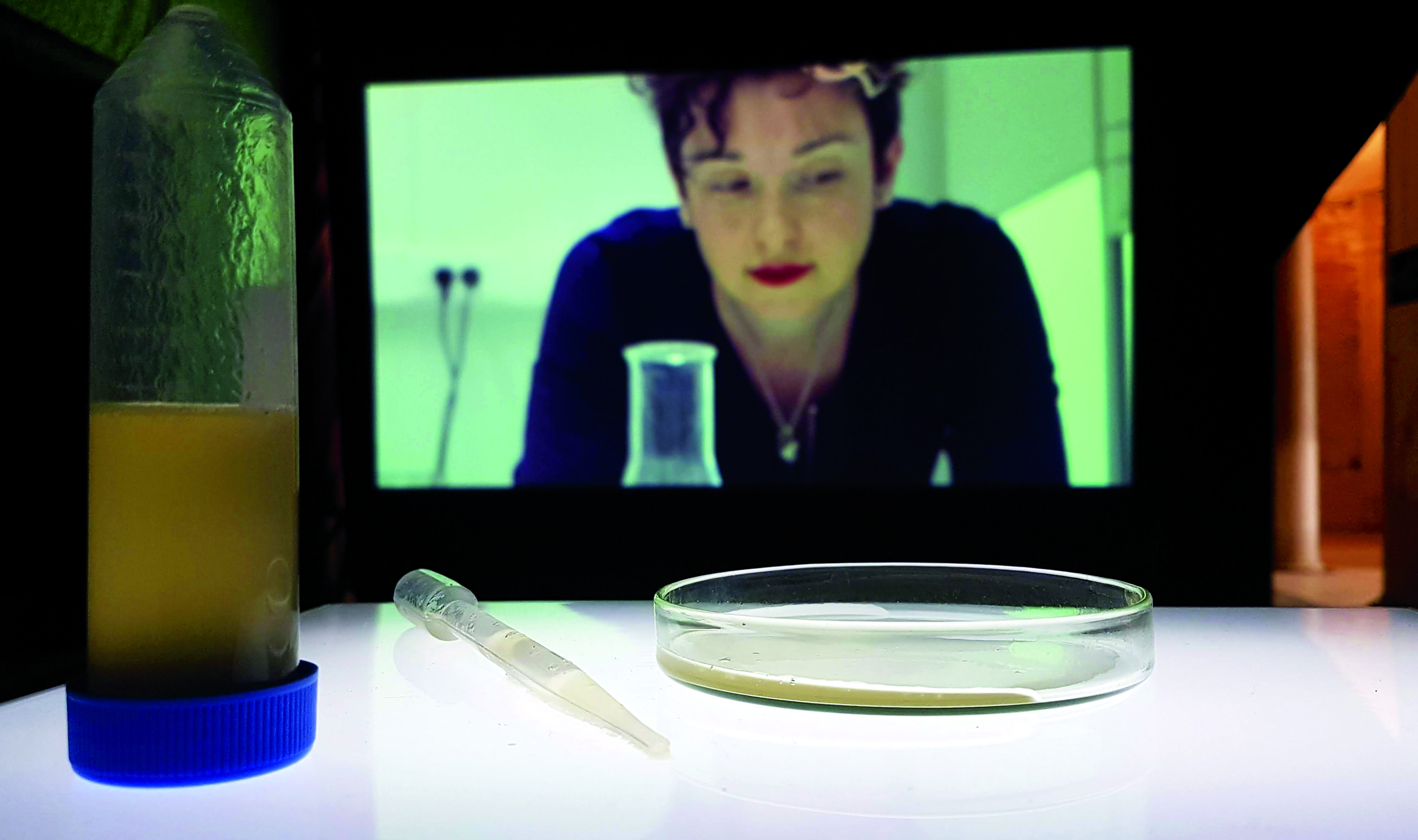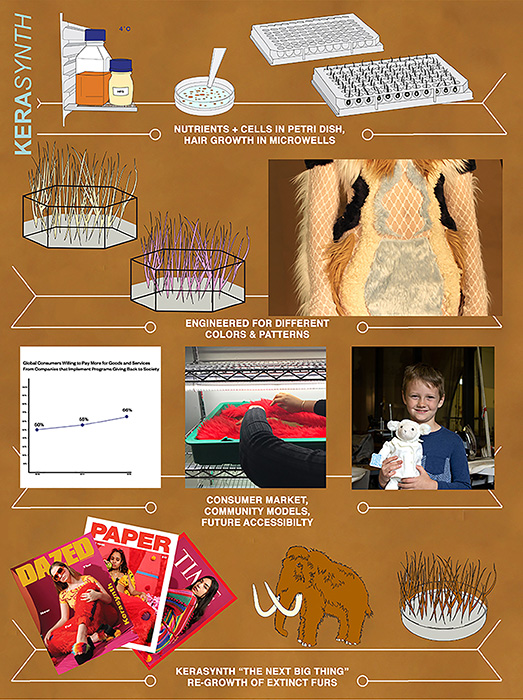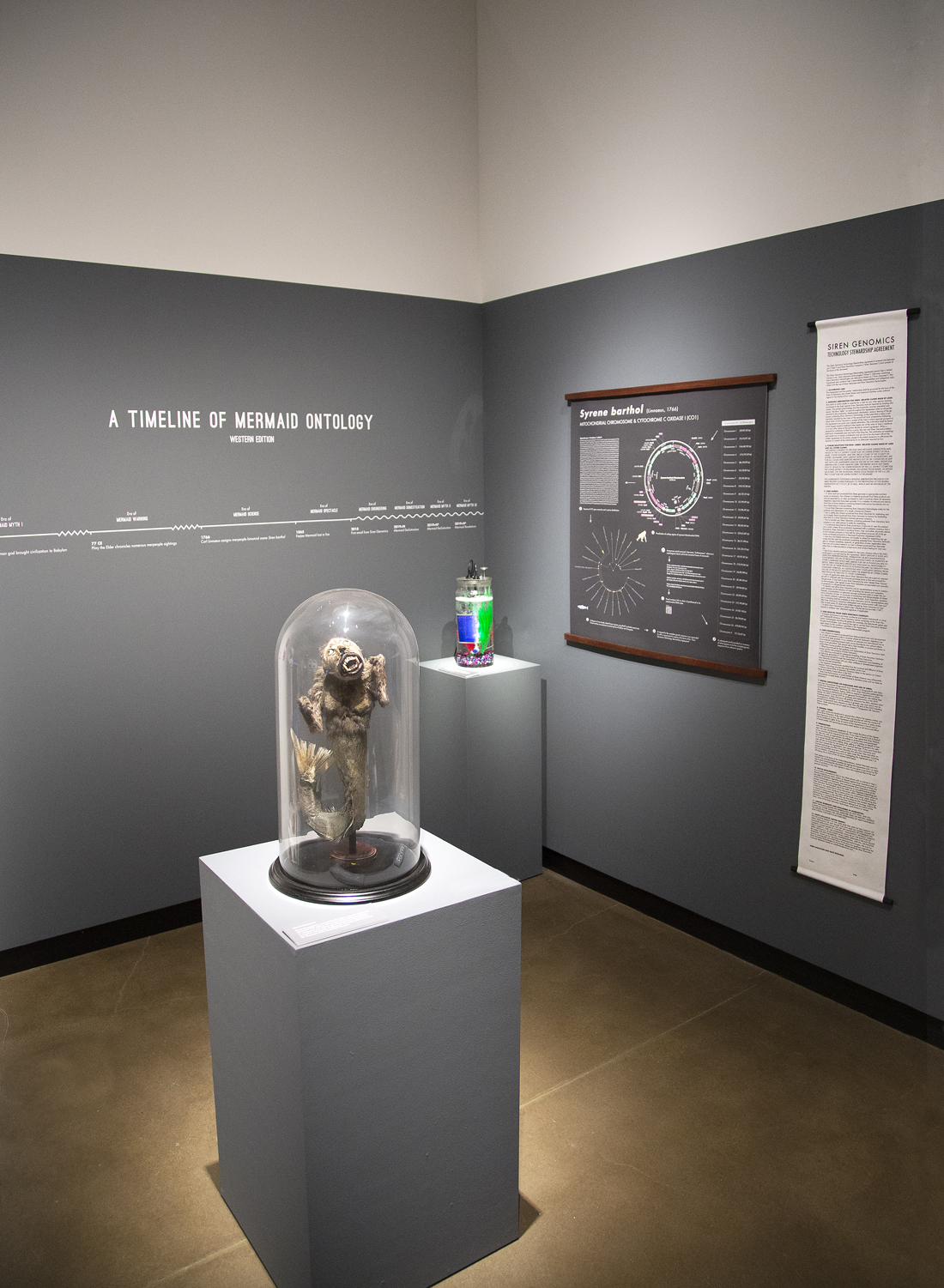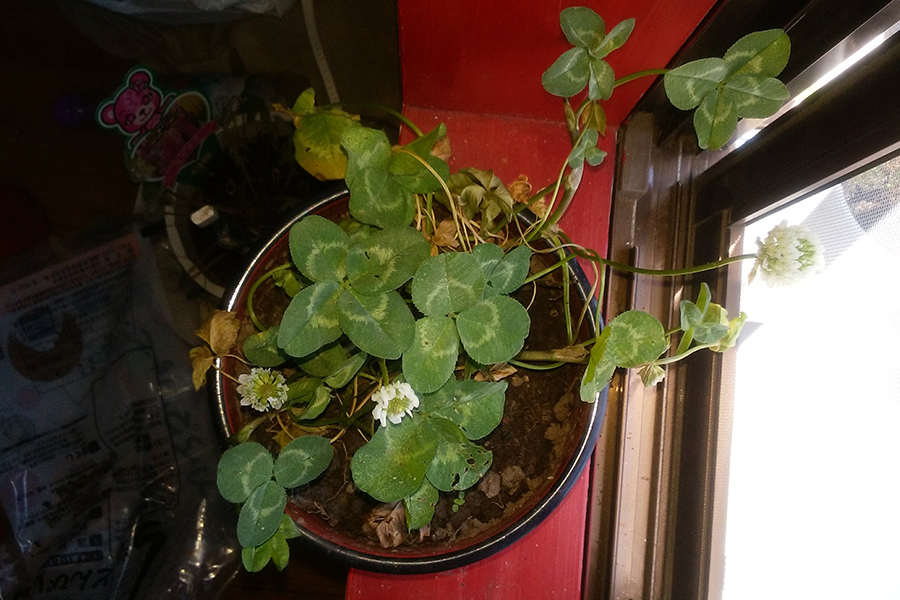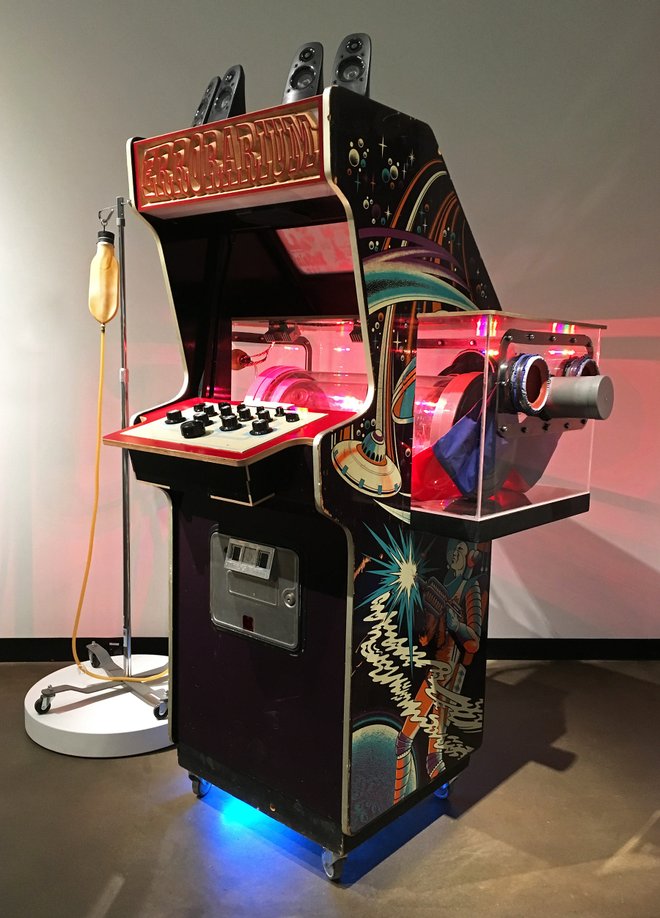For this exhibit, we invited artists, scientists, designers, and makers at all career stages to submit proposals responding to the question: How do artists and designers contribute materially, rhetorically, and conceptually to modern biotechnology?
Human engagement with biotechnology through art and culture has a long history: from Popol Vuh creation stories and Mayan representations of agriculture to contemporary artists’ ethical takes on the genomic age. Art’s Work/Genetic Futures extends this history through works that prompt new ways of thinking while emphasizing the historical context of biotechnological innovation, medical practice, and genomic science. By bringing art and modern biotechnology together, we aim to reach toward new understandings about the human condition, our bodies, the environment, and the other species that share the planet.
Exhibition Catalog
A full-color, 144-page, printed catalog of the exhibition is available through UNC Press. The catalog is also viewable as a PDF online here.
Suzanne Anker
SUZANNE ANKER is a Bio Art pioneer, visual artist and theorist working at the intersection of art and the biological sciences. Her practice investigates the ways in which nature is being altered in the 21st century. Concerned with genetics, climate change, species extinction and toxic degradation, she calls attention to the beauty of life and the “necessity for enlightened thinking about nature’s ‘tangled bank’.” Her work has been shown internationally in Biennials, museums and galleries. Her books include “The Molecular Gaze: Art in the Genetic Age”, “Visual Culture and Bioscience” among others. Chairing SVA’s Fine Arts Department in NYC since 2005, Ms. Anker continues to interweave traditional and experimental media in her department’s new digital initiative and the SVA Bio Art Laboratory.
Website | suzanneanker.com
Twitter | @suzanneanker
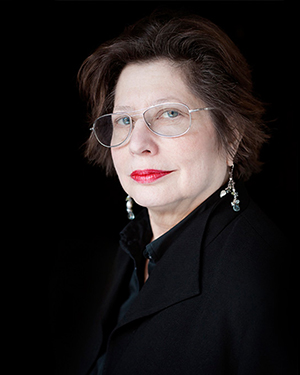
Credit: Raul Valverde
Laboratory Life (for Oryx and Crake)
Both laboratories and gardens are artificially created. They are constructed spaces, framed with either pastoral delight in mind, or as a site where nature is scrutinized, expecting to surrender its secrets. Gardens can be playful but also accommodate roving bands of plant and animal life: seeds, insects, birds, moles, and even turtles. There is no possible containment for a garden. Fences cannot keep airborne substances out of its sanctioned space. Gardens function as a slice of arcadia where nature on the surface seems to be cultivated. Laboratories require stricter controls so as not to contaminate research results and are equipped with sealed doors, sterilization units and filtered air.
These open and closed practices, being in the nature/culture nexus, represent current osmotic flow as each side inches towards the other’s domain. As nature becomes “culturized”, that is, manipulated and transformed, culture absorbs and expands upon these changes. “Laboratory Life (for Oryx and Crake)” is an ode to Margaret Atwood’s novel in which nature and technology are absorbed in dystopian ways.
Related: Artist Talk with Suzanne Anker, Nov. 14 @ Gregg Museum–
Related: An Evening with Margaret Atwood, Nov. 15 @ Talley Student UnionJoe Davis + Dana Dal Bo
JOE DAVIS pioneered laser carving methods at Bell Telephone Labs and U. Cincinnati Medical Center in the 1970s. In 1981 he joined MIT Center for Advanced Visual Studies as Research Fellow and Lecturer. His Microvenus (1986) was the first genetically engineered art. Davis joined Alexander Rich laboratory at MIT in 1989 and the Harvard laboratory of George Church in 2010 as “Artist Scientist.” Davis is also affiliated with Thomas Schwartz Lab at MIT and Ashley Seifert Lab at University of Kentucky.
DANA DAL BO works as an artist on a number of multidisciplinary research teams (co-inquiries) that cross art, science, and medicine including Hybrid Bodies which explores the phenomenological aspects of organ transplant and donation, and Space Tango where, as Artist in Residence she is researching the artistic potentials of the microgravity environment. In looking back at the history of science, medicine and psychology she disrupts the empire of the empirical as the only measure for determining the healthy from the aberrant. Dal Bo’s work always evokes a seductive, speculative future that is grounded in an eerie pan-optical present. Her work has been exhibited internationally including the National Gallery of arts in Tirana, Albania and Volta13 at Art Basel in Switzerland. She is currently a PhD candidate at USC in Media Arts + Practice (MA+P).
websites | Wikipedia Profile: Joe Davis (artist) | Dana Dal Bo

Credit: Robert Davezac
Lucky Mice
Lucky Mice was inspired by Larry Niven’s fictional Ringworld series where aliens carry on secret experiments to enhance good luck through human breeding. While serendipity might be ascribed to chance, closer examination suggests it is chance coupled with coincidence. Both judgment to recognize, and ability to accommodate unexpected events underlie all serendipitous discovery. History recounts many unexpected accidents that, through reasoning and deduction become transformed into opportunity. Investigations of luck have been undertaken in psychology, cognitive science, information science and economics, but correlations of serendipity and genetics have never been studied. Production of enhanced traits in Homo sapiens would take centuries, but a single generation of mice can be produced in only about 12 weeks. Proposed experiments will observe serendipitous behaviors with mouse-operated dice-throwing apparatus and pursue in vivo selective breeding of “lucky mice.” This scientifically rigorous approach will abide with protocols for ethical research and humane treatment of laboratory animals. No performance-enhancing drugs or genetic modifications will be administered to mice. Use of live mice highlights human-animal relationships in art and science and examines protocols underlying use and care of laboratory animals.
Related: Lucky Mice (Throwing Dice), Oct. 17 @ D.H. Hill Library
Jon Davis
JON DAVIS is a Research Triangle-based graphic designer and animator. Jon was a researcher for over ten years in the fields of plant biology and protein structure at the graduate and post-doctoral levels before leaving the laboratory to focus on exploring science through art, merging his experience as a scientist with a lifelong interest in computer graphics to create data-based CG works. Jon uses computer graphics and physics modeling as media to examine, explain, and explore science through art. Through his company, Scientific Studios, Jon collaborates with scientists and educators to visualize data and communicate scientific advancements.
Website | scientificstudios.com
Twitter | @Science_Studios
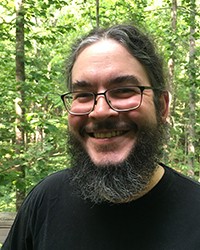
From Teosinte to Tomorrow: Teosinte “time-lapse” animation
As they reach the end of the virtual corn maze in the From Teosinte to Tomorrow VR experience, the visitor sees a teosinte plant emerge and grow to maturity in a few seconds. This computer-generated 3D animation was created using time-lapse videos of real plants as guides and inspiration. Each leaf blade is animated independently, reflecting the daily and seasonal movements plants make as they track the sun during growth. The compression of an entire growing season into less than a minute references our perception of time, intersecting with the theme of how we understand the passage of time in the historical context of the development (via human intervention) of corn from teosinte, and currently, as new technologies are applied in agriculture and other aspects of human experience.
Related: Symposium Panel – 3—4 pm: Genetic Arts Intervening in the Anthropocene: Climate, Geoengineering, and Ecosystems, Oct. 18 @ D.H. Hill LibraryHeather Dewey-Hagborg
DR. HEATHER DEWEY-HAGBORG is a transdisciplinary artist and educator who is interested in art as research and critical practice. Heather’s work is held in the public collections of the Centre Pompidou, the Victoria and Albert Museum, and the New York Historical Society and has been widely discussed in the media, from the New York Times and the BBC to Art Forum and Wired.
Heather has a PhD in Electronic Arts from Rensselaer Polytechnic Institute. She is an artist fellow at AI Now, an Artist-in-Residence at the Exploratorium, as well as Science Center, and is an affiliate of Data & Society.
She is also a co-founder and co-curator of REFRESH, an inclusive and politically engaged collaborative platform at the intersection of Art, Science, and Technology.
Website | dewey-hagborg.com
Stranger Visions
Stranger Visions artist Heather Dewey-Hagborg creates portrait sculptures from analyses of genetic material collected in public places. Working with the traces strangers unwittingly leave behind, Dewey-Hagborg calls attention to the developing technology of forensic DNA phenotyping, the impulse toward genetic determinism and the potential for a culture of genetic surveillance.
To create the sculptures, Dewey-Hagborg collected hairs, chewed up gum, and cigarette butts from the streets, public bathrooms and waiting rooms of New York City. She extracted and analyzed each sample’s DNA to computationally generate 3d printed life-size full color portraits representing what those individuals might look like, based on genomic research. The artist has devoted critical efforts to discussing the limitations and bias in phenotyping technology, which she (and many scientists) do not consider accurate or impartial enough for use in criminal investigations.
Stranger Visions was created with the support of Eyebeam and the mentorship of Genspace and NYU’s Advanced Media Studio. It is in the collection of the Centre Pompidou and private collections worldwide.
Aaron Ellison + David Buckley Borden
The creative team of DAVID BUCKLEY BORDEN and AARON M ELLISON unites art, design, and environmental science in place-based projects. Their art installations illustrate novel ecological systems (“ecosystems”) that people create by changing the environment. In their creative practice, David and Aaron engage with local communities to learn about their lives, practices, cultures, and customs, and create visual art that often uses vernacular tropes to envision our changing world. David and Aaron’s research-driven creations communicate abstract, often technical ecological concepts. Their installations provide spaces for thoughtful consideration and provocative discussions about how humans are altering the environment and the opportunities available to collectively rethink all our actions, for better or worse.
AME | unbalancedecologist.net and @AMaxEll17
DBB | davidbuckleyborden.com and @dbuckleyborden
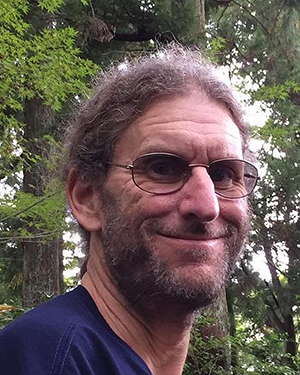
Aaron Ellison; credit: Flossie Chua
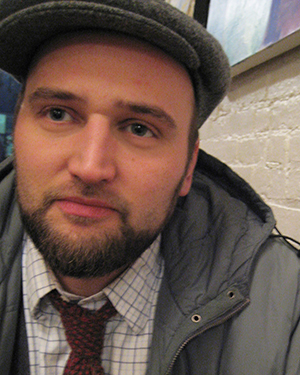
David Buckley Borden
Novel Ecosystem Generator
The Novel Ecosystem Generator is a playful kinetic public art installation designed to represent a process engine that takes in existing genes, organisms, or entire ecosystems, restructures and rearranges them, and outputs new biological systems. Before and after conditions represented in the artwork challenge viewers to consider profound examples of this Anthropocene phenomena.
People are disassembling, rearranging, and restructuring genes, organisms, ecosystems, and the environment that supports them and us. This process of creating novel ecosystems occurs both deliberately and unintentionally. For example, deliberate cross-breeding, production of genetically modified organisms (GMOs), introduction of “gene-drives” for mosquito control, or gene splicing using CRISPR-CAS9 result in the introduction of new kinds of plants and animals. These intentional introductions engender new interactions in ecosystems that have been in place for millennia. Similarly, people transport species from state to state and between countries, leading to the arrival and spread of “invasive” species in new places. These movements of species and their interaction with “native” ones, coupled with ongoing, human-caused changes to the land, sea, and climate, together lead to unexpected and unintended consequences. Such “unintentional genetic engineering” is happening continuously and, like its intentional counterpart, has great potential to cause dramatic environmental change.
Related: Symposium Panel – 3—4 pm: Genetic Arts Intervening in the Anthropocene: Climate, Geoengineering, and Ecosystems, Oct. 18 @ D.H. Hill LibraryEmeka Ikebude
EMEKA IKEBUDE’s work interrogates the themes of dislocation and fragmentation from a biopolitical perspective, and locates at the liminal intersections of tradition and modernity, art and technology/biotechnology. A winner of several awards, his techniques include transforming everyday materials like wood, fabric, and metal into a distinctly characterized aesthetic. In much of his work, Emeka employs the techniques of contouring, layering, mapping, digital visualization, welding, cutting, fraying, dyeing, gluing, and stitching. He uses these techniques to synthesize diverse and, often, minute forms into massive, variegated compositions because he is allured by the beauty and balance inherent in unity, and the force that forms when people unite.
website | emekaikebude.wixsite.com/emekaikebude; @77emeka
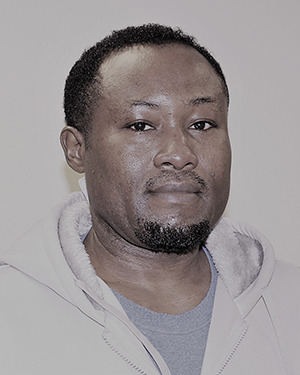
Fragments
In ‘Fragments’, I have used hundreds of thousands of re-purposed toothpicks which I collected from mainly restaurants where they were used for picking teeth and discarded. I then dyed them with organic dyes that are harmless to the environment.
Essentially, they still retain human DNAs and microbiomes through the saliva, blood, and food particles on the toothpicks, that imbue them with a life of their own. Thus, the current condition of the toothpicks as microbial forms raises questions about the sanitary conditions of the food we eat and the environments in which they are processed. All these locate ‘Fragments’ at an intersection of art and biotechnology, where our understanding of the complex relationship with the microbial community would help inform a better understanding of the human body, better health and improved well-being.
Collecting the toothpicks raised critical questions about the unsanitary condition of the food we eat and the conditions in which they are prepared. Thus, each toothpick in this composition represents a human being – a contributor and unwitting participant in this project of rethinking the bacterial and viral genomes of the human body.
Related: Symposium Panel – 4—5 pm: Art and Identities: From Surveillance and Privacy to Collective Identities and Personal Choices, Oct. 18 @ D.H. Hill LibraryCharlotte Jarvis
CHARLOTTE JARVIS is an artist and lecturer working at the intersection of art and science. She approaches bodies as liminal spaces – sites for transformation, hybridization and magic. Charlotte uses stem cell technology, personalized medicine, transplantation and augmentation to ask what is a human body? Can we define it? Should we try?
Charlotte has been exhibited in ten international solo shows and over a hundred group exhibitions at venues including the Wellcome Collection, Victoria & Albert Museum, Kapelica Gallery, the Guangzhou Triennale and the Venice Biennale. Charlotte has been resident artist at the European Bioinformatics Institute, The Netherlands Proteomics Centre and the Hubrecht Institute. She lectures at the Royal College of Art, Goldsmiths University, Central Academy of Fine Art Beijing and Imperial College.
website | cjarvis.com
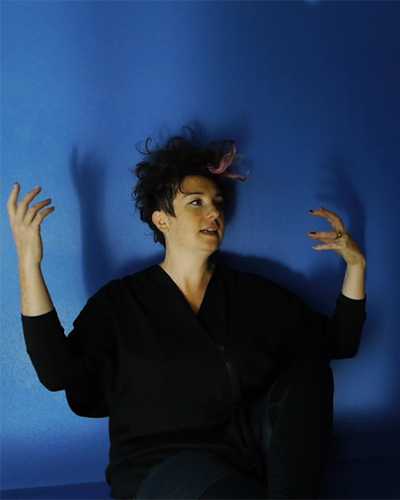
In Posse
Throughout history, semen has been revered as a magical substance – a totem of literal and symbolic potency. Patriarchal societies have described semen as life force, a drop of the brain, and that which sows the seeds of virtue in the female soul. In Posse aims to rewrite this cultural narrative; to use art and science to disrupt the hierarchy.
Artist Charlotte Jarvis is collaborating with Prof Susana Chuva de Sousal Lopes and Kapelica Gallery / Kersnikova Institute to make semen from her (“female”) stem cells. To do this they are using stem cells derived from Charlotte’s blood, altering their gender and differentiating them into the sperm producing cells found in male testicles.
The project is presented as part of a contemporary reenactment of the ancient Greek festival of Thesmophoria – a women-only fertility ceremony in honor of the goddesses Demeter and Persephone. Charlotte has used her female sperm as a starting point for reimagining Thesmophoria: for populating a history without patriarchy and a future in which the gender/genital power balance is redressed.
Related: Symposium Panel – 4—5 pm: Art and Identities: From Surveillance and Privacy to Collective Identities and Personal Choices, Oct. 18 @ D.H. Hill LibraryKerasynth
KERASYNTH is a collaboration among fiber artists DIANA EUSEBIO, ERIN KIRCHNER, GRACE KWON, RACHEL RUSK, and SYDNEY SIEH-TAKATA concerned with the intersections among tissue engineering, sustainably sourced materials, and accessibility.
Their work was a finalist for the 2018 Biodesign Challenge’s Animal Free Wool Prize and overall competition, received press coverage from Medium: Neo.Life, Smithsonian.com, and Forbes, and presented to a major wool company at the 2018 Outdoor Retailer Winter Market. They are currently brainstorming ways for this major wool company to assist them in pushing the project forward while each pursue their creative interests and professional goals.

Kerasynth
Kerasynth is a synthetically grown biological material that can replace all keratin-based animal fibers. It takes the approach of using tissue engineering to grow wool Hair Follicle Germ (HFG) cells on microfluidic devices designed to provide the cells with nutrients and to remove waste. The subsequent wool could then be harvested and further processed or remain attached to the microfluidic device.
Eventually, using non-animal derived growth media for cell culturing and more biodegradable alternatives for the PDMS used to make the microfluidic devices could make creating a completely vegan wool from a biodegradable support possible in the near future.
Another component of our project is to propose ways for making tissue engineering a more accessible technology through community-based educational models in schools and vocational training programs. In order to realize this goal, we have created a speculative company named DermaWool that would develop and patent this method of production before licensing other companies to use their technology in other ventures. By democratizing the knowledge and resources used in creating Kerasynth, we hope to provide a material solution that not only addresses human consumer needs and protects animal welfare, but is also inclusive in its production.
Related: Symposium Panel – 3—4 pm: Genetic Arts Intervening in the Anthropocene: Climate, Geoengineering, and Ecosystems, Oct. 18 @ D.H. Hill LibraryMaria McKinney
MARIA MCKINNEY (b. 1982) is an Irish visual artist and is currently a member of Temple Bar Studios, Dublin.
She works across a range of media and has made a number of solo exhibitions, including at the Wellcome Collection, London UK (2018), RHA, Dublin, Ireland (2016), Lokaal 01, Antwerp, Belgium (2016) and the MAC, Belfast, UK (2012). Her work was shortlisted for the MAC International Prize 2014, selected by Hugh Mulholland, Judith Nesbitt and Francesco Bonami. She has taken part in a number of artist residencies including Skowhegan 2017.
In 2019 she will realise a project about the Jersey cattle breed on the island of their origin and namesake.
website | cargocollective.com/mariamckinney

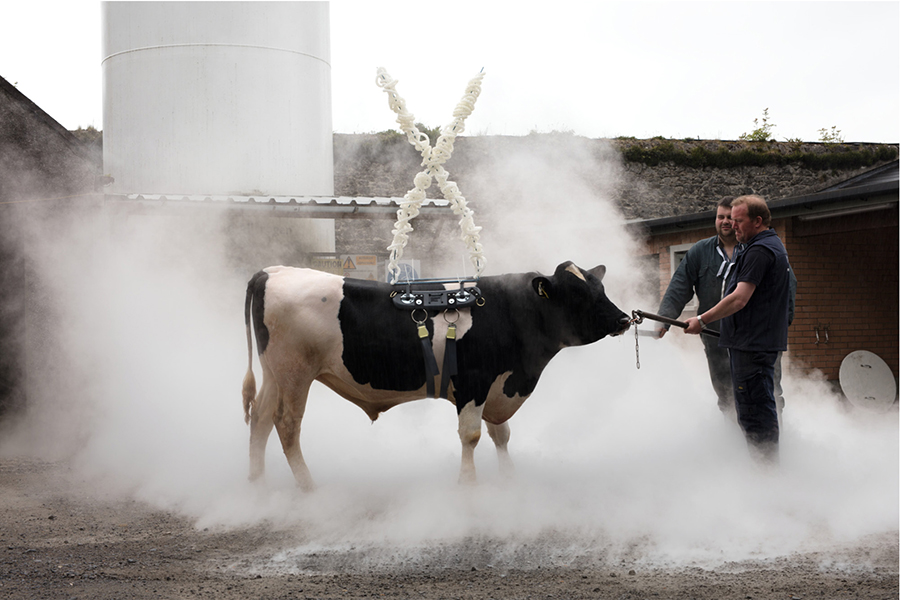
Sire
In pre-Christian Europe, people annually performed customs in relation to the reaping and sewing of the harvest. These rituals have since been popularly interpreted as an attempt to influence the future behaviour of nature.
Part of this practice involved making a corn dolly, an object made through the intricate handcraft of binding straw with the final sheaf of that year’s crop. This doll has since become a symbol of fertility, both of the land and the living creatures that feed off it. In contemporary society however, the branch of knowledge known as genomics has given humans the ability to truly influence how nature behaves in future generations of animal and plant species.
Having gained an understanding of the complex structure of genes and their functionality, the emergence of bioinformatics has allowed scientists to direct breeding strategies with the objective of achieving more physically healthy and commercially productive animals. The body of work Sire is proposed as a rephrasing of what was once intangible. Now we not only understand these formerly mysterious processes of propagation, but also manipulate them to our own ends.
Joel Ong
JOEL ONG is Assistant Professor in Computational Arts at York University. His research explores emergent ways of interfacing with the natural elements through the lens of digital and moist-media technologies. He is an alumni of SymbioticA, the Centre of Excellence in BioArts and is also an artist with the UCLA ArtSci Collective. Ong’s individual and collaborative works in spatial sound, data aesthetics and interactive media have been presented in festivals and conferences across Canada, USA, UK, Australia, Mexico and Singapore.
website | arkfrequencies.com

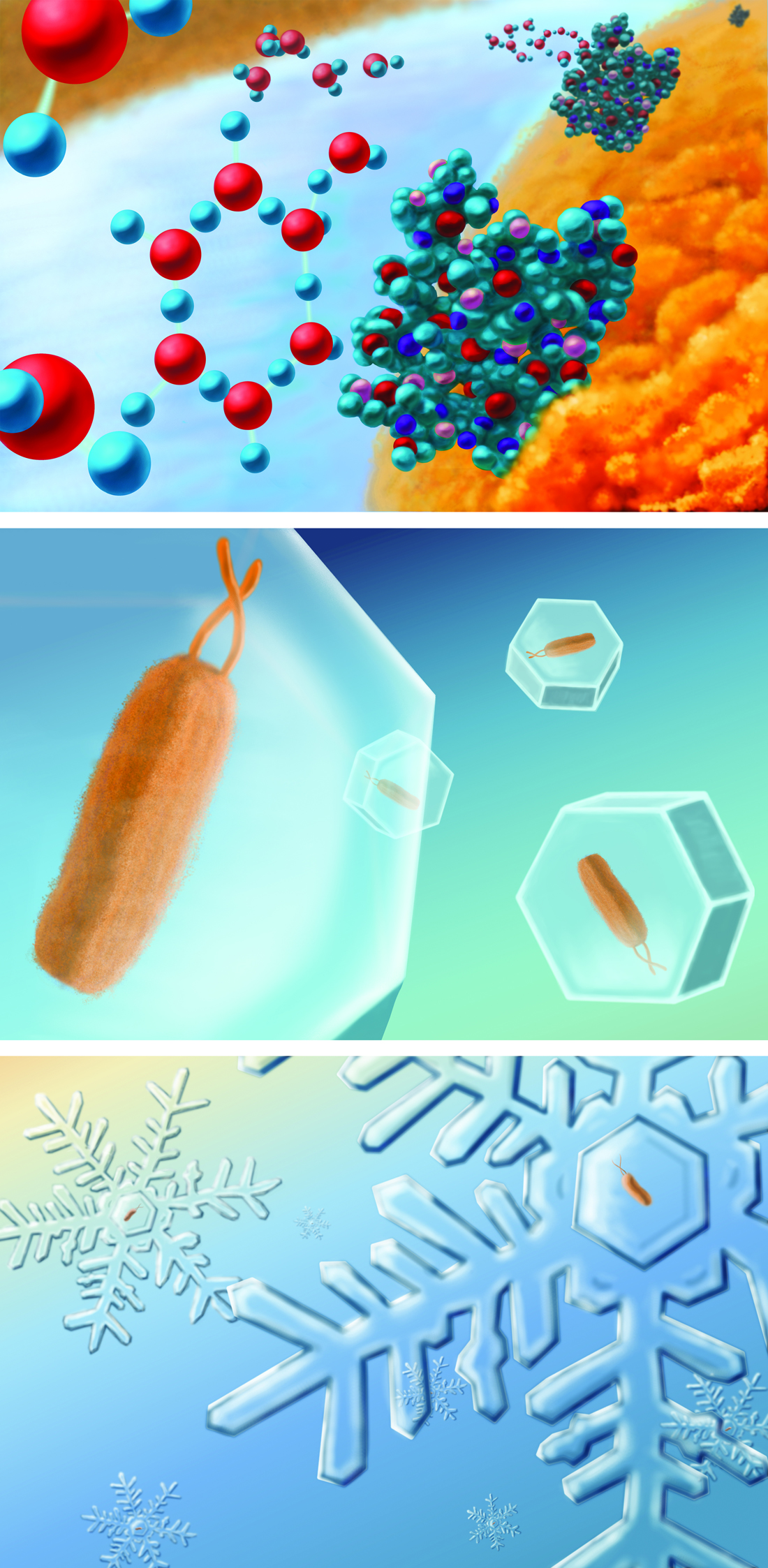
Terra Et Venti by Joel Ong (2019), artist rendering of Pseudomonas syringae ice-nucleation process, digital prints | Computer visualization by Natalie Plociennik
Terra Et Venti
Terra Et Venti is a research-creation project that explores the role synthetic biology may play in planetary scale geoengineering and weather modification practices in the near future. The work exists in a triptych of forms – in vivo, in vitro and in silico, providing a microbial mise-en-scene within which multi-scalar and multi-dimensional activities can be composed. Shown in the gallery are visual documentations of laboratory and field work, a simulation of cloud formation and a generative spatial sound composition.
The main research focus of the project is the transgenic modification of P.syringae with genetic poetry. In speculating future laboratory practices in synthetic biology that enhance or modify our atmosphere, the non-utilitarian nature of this mutation is poignant because it presents a genetic future beyond the function/dysfunction polemic of genetic modification by beginning with an aesthetic catalyst.
The computational system presented in the gallery generates text for insertion into the bacteria’s genome. It then predicts the new molecule’s 3D morphology and ice nucleation ability and generates a digital cloud in real time. Extending this experientially is an array of parametric speakers that punctuate the space with short bursts of noise, providing the metaphor of disruption in an otherwise buoyant and atmospheric soundscape.
Related: Symposium video with NC State Lecturer Darrell Stover, reading his poem reflecting on Terra e VentiRichard Pell
RICHARD PELL is Curator at the Center for PostNatural History in Pittsburgh, Pennsylvania. Founded in 2010, the Center for PostNatural History collects organisms that have been intentionally and heritably altered by humans by means including selective breeding or genetic engineering. He is an Associate Professor at Carnegie Mellon University.
website | postnatural.org/
Twitter | @postnatural
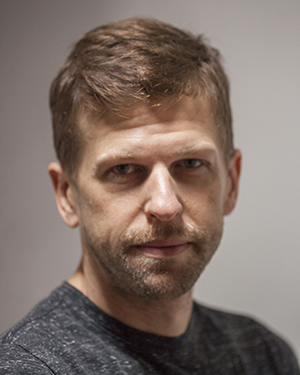
The Mermaid De-Extinction Project
The Mermaid De-Extinction Project examines historical and recent developments with respect to our scientific relationship to mythological mermaids. Beginning with early modern scientists descriptions of mermaid sightings, proceeding through 19th century “Feejee” mermaid specimens and culminating with the ongoing effort to understand or falsify mermaid-like genomic data originating from the Siren Genomics revelations.
Related: Symposium Panel – 2—3 pm: Biotechnology as Culture, Oct. 18 @ D.H. Hill LibraryCiara Redmond
CIARA REDMOND is an emerging contemporary artist working in mixed media, installation and bioart. Redmond’s work explores themes of identity, genetic destiny, gender and the relationship between science and culture. Redmond trained in materials conservation and works with artists and galleries to find innovative solutions for displaying unusual works and materials. Redmond is from Melbourne, Australia and currently based in Tokyo, Japan. You can find more of their work at:
website | instagram.com/clover.makes.things and https://ciararedmond.cargocollective.com/

We Make Our Own Luck Here
We Make Our Own Luck Here investigates the relationship between biotechnology and culture using four leaf clovers, a symbol for luck. Using traditional selective breeding methods (mating two plants with desirable traits and planting the seeds) I have created white clover (Trifolium repens) plants with high numbers of four-leaf clovers. These specially created clover plants are shown along with notes explaining the science of the four-leaf trait. Are lucky four-leaf clovers still lucky if we use science to make them common? Scientists use biotechnology to transform our societies but we can quickly take these innovations for granted. Even antibiotics have gone from being the saviour of humanity to being overused to the point of creating new problems in less than a century. Can we that find joy from biotechnology outside of traditional research? Or should we be critical of how humanity might frivolously use its power?
This project is developed with support from Waseda University.
Related: Symposium Panel – 2—3 pm: Biotechnology as Culture, Oct. 18 @ D.H. Hill LibraryKirsten Stolle
KIRSTEN STOLLE is a visual artist examining the impact of biotechnology and agribusiness on our food supply. She is a Pollock-Krasner Grant recipient and her work is included in the collections of the San Jose Museum of Art, Crocker Art Museum, and Minneapolis Institute of Arts. Solo exhibitions include NOME (Berlin), Southeastern Center for Contemporary Art (NC), Turchin Center for Visual Arts (NC), Winthrop University Art Galleries (SC), Tracey Morgan Gallery (NC) and Jack Fischer Gallery (CA). Group exhibitions include Balzer Projects (Basel), Fridman Gallery (NYC), The Mint Museum (NC), and The Billboard Creative (CA). Her work has been published in Poetry, Burnaway, Topic, Creators Project, and New American Paintings.
websites | kirstenstolle.com and traceymorgangallery.com
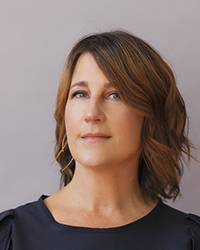
Chemical Bouquet II
Chemical Bouquet examines the overuse of pesticides and the introduction of GMOs through the lens of ornately framed 19th century floral still life painting. Victorian flower bouquets overflowing with familiar botanical plants have been subverted and populated with odd and unsettling imagery associated with chemical intensive farming practices.
Beautiful flowers have been replaced with bloated cow udders, syringes, 18-20th century medicinal and botanical plants (corn, soy, rapeseed, cotton), Agent Orange barrels, and aspirin pills and bottles—all components associated with Monsanto Chemical Company products. Collage material cut from vintage botanical lithographs, pharmaceutical catalogs, and agricultural (USDA) manuals.
Related: Symposium Panel – 2—3 pm: Biotechnology as Culture, Oct. 18 @ D.H. Hill LibraryEmilia Tikka
EMILIA TIKKA (FI) is an artist working in the intersection of Speculative Storytelling and Synthetic Biology. Her interdisciplinary practice explores philosophical dimensions and cultural implications of novel biotechnologies such as genome editing technology CRISPR. Her methods of research vary from designing objects, constellations and fictions to hands-on experiments in a laboratory. She has been recently selected as the artist in residence at Max-Delbrück-Centre for Molecular Medicine and State Festival, the first European artistic residency on CRISPR. Her art works has been exhibited in Ars Electronica in AU, NYU Arts Center in UAE and EMMA Contemporary Art Museum in FI to mention few. Her work has been recently featured in publications such as Nature and Süddeutsche Zeitung.
website | emiliatikka.com, instagram.com/emiliatikka/

Credit: vog.photo
EUDAIMONIA – Biotechnologization of the Soul?
Eudaimonia is a philosophical-speculative future scenario where human psyche and character has become a matter of molecular biology and can be altered with personalized genome editing device. Today scientists claim to have found that specific genes fundamentally determinate human behaviour. Explicit features of character and psychological qualities, such as empathy and creativity, are traced even to a single allele of a gene. These claims open up the question of whether the “optimization” of the human psyche would become an issue of genome editing and biotechnology. The work raises questions about possible impacts of the novel genome editing technology CRISPR through a critical near future scenario. The art work is realized as a fictional genome editing device, as a desirable consumer product and as a short film imagining the possible societal impacts of the technology: a dark poetic story of three individuals seeking help from mysterious gene editing technology in their quest to find happiness in contemporary western capitalistic world. The near future scenario thematizes the phantasmatic drive towards happiness as the ultimate goal of human existence.
Related: Eudamonia Screening at GES Colloquium, Nov. 26 @ Poe 202Paul Vanouse
PAUL VANOUSE is an artist and professor of Art at the University at Buffalo, NY, where he is the founding director of the Coalesce Center for Biological Art. Interdisciplinarity and impassioned amateurism guide his art practice. His bio-media and interactive cinema projects have been exhibited in over 25 countries and widely across the US. Venues have included the Walker Art Center in Minneapolis, New Museum in New York, Museo Nacional in Buenos Aires, Haus der Kulturen der Welt in Berlin, ZKM in Karlsrhue, and Albright-Knox in Buffalo. Vanouse’s artworks have been funded by Rockefeller Foundation, Creative Capital Foundation, New York State Council on the Arts, New York Foundation for the Arts, Sun Microsystems and the National Science Foundation. He has received numerous awards at festivals including a Golden Nica and two Awards of Distinction at Prix ARS Electronica, in Linz, Austria. He has an MFA from Carnegie Mellon University.
website | paulvanouse.com
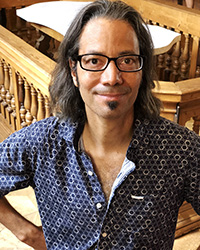

America Project
The “America Project” is a biological art installation centered around a process called “DNA gel electrophoresis”, AKA “DNA Fingerprinting”, a process I’ve appropriated to produce recognizable images. Audiences first encounter what resembles a human-scale fountain or decanter, which is actually a spittoon to collect their spit.
Prior to the opening, I extract the DNA from hundreds of spit samples, containing cheek cells and the cells’ DNA all mixed together. The DNA was not individuated nor retained: it was processed as a composite to make iconic DNA Fingerprint images of power—such as a crown and a flag—which are visible as video projections of the electrophoresis gels throughout the exhibition.
These images form because DNA of different lengths move at different speeds in a polarized electrophoresis gel. While in typical DNA images these appear like rows of abstract barcodes, I use methods which allow me to amplify DNA to exact lengths, which when run in the gel create planned, recognizable images. Since our DNA is 99.9% the same between individuals, one can easily make DNA images that don’t actually differentiate humans. What is visualized from the promiscuously co-mingled DNA in the “America Project” is our shared identity, our collectivity.
Related: Spit Collection for The America Project, Oct. 16 @ Talley Student Union–
Related: Symposium Panel – 4—5 pm: Art and Identities: From Surveillance and Privacy to Collective Identities and Personal Choices, Oct. 18 @ D.H. Hill LibraryJennifer Willet
Dr. JENNIFER WILLET is a Canada Research Chair in Art, Science, and Ecology and an Associate Professor in the School of Creative Arts at the University of Windsor (Canada.) Willet is Director of INCUBATOR Lab a BSL2 bioart research facility and INCUBATOR Studio a BSL1 artist studio in Downtown Windsor. She is an internationally successful artist and curator in the emerging field of bioart.
website | jenniferwillet.com and incubatorartlab.com
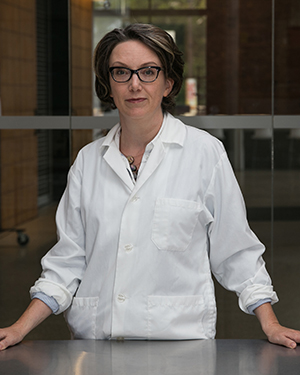
credit: Josh Babcock
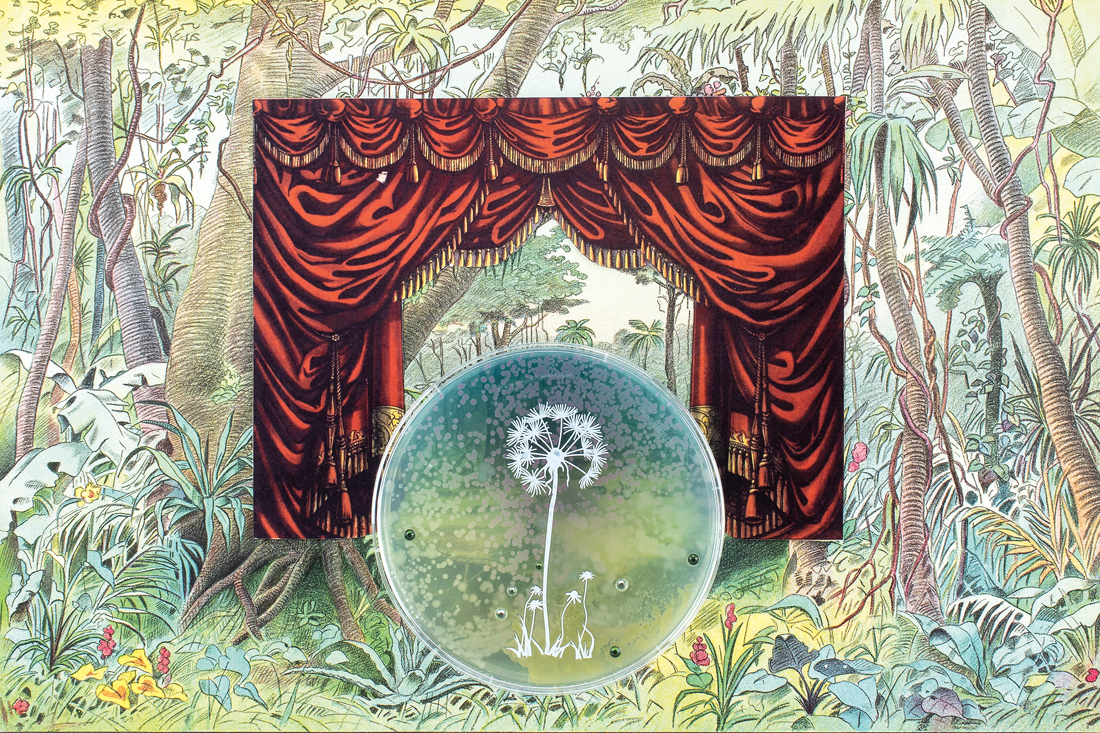
Baroque Biology (Paper Theatre) by Jennifer Willet (2019), petri dishes, agar, GMO bacteria, collage materials | Mixed-media collages photographed by Justin Elliott
credits: papertheatre – J.Willet; other images – Josh Babcock
Baroque Biology (Paper Theatre)
Baroque Biology (Paper Theatre) is a series of large (25 cm x 25 cm square) LB Agar petri dishes containing imaginary biological vignettes where non-human organisms teach humans complex biotechnological processes within the context of a paper theatre show. Reminiscent of William Hogarth’s serial engravings or fairy tales from a biotech future – each allegory focuses on a fox, or a microbe, a plant or fungi, who tries to communicate with humans in a helpful manner about the biological processes they employ for survival, for reproduction, and/or aesthetic pleasure.
Sometimes the human characters are open to receiving the communicated information, and sometimes they are hostile, or ignorant to the messages they are receiving across species. Each petri dish contains paper cut outs, gold leaf, temporary tattoos, and 3D sculptural agar forms seeded with genetically modified rainbow-colored bacteria. This is a durational artwork where the Petri dishes slowly become confluent with microbes interacting with the collage elements in the dish.
Related: Symposium Panel – 2—3 pm: Biotechnology as Culture, Oct. 18 @ D.H. Hill LibraryAdam Zaretsky
ADAM ZARETSKY is a Wet-Lab BioArt Practitioner mixing Ecology, Biotechnology, Non-human Relations, Body Performance and Gastronomy. Zaretsky stages lively, hands-on bioart production labs based on topics such as: foreign species invasion (pure/impure), radical food science (edible/inedible), jazz bioinformatics (code/flesh), tissue culture (undead/semi-alive), transgenic design issues (traits/desires), interactive ethology (person/machine/non-human) and physiology (performance/stress). Zaretsky runs a public life arts school: VASTAL (The Vivoarts School for Transgenic Aesthetics Ltd.) teaching experimental bioart classes, messy labs and hands-on biotech at art events, universities (i.e. SFSU, SymbioticA-UWA, RPI, University of Leiden, CMU, NYU) and in public venues. His art practice focuses on an array of legal, ethical, social and libidinal implications of biotechnological materials and methods with a focus on transgenic humans.
Errorarium Design: a Zaretsky/Juday/Edwards Collaboration Errorarium Architecture and Fabrication: Mason Juday | masonyte.com
Errorarium Experimental Light Synthesizer Engineer: Pete Edwards of Casper Electronics | casperelectronics.com
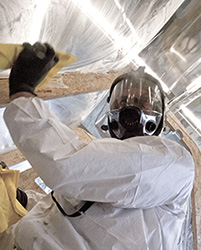
Errorarias: Bipolar Flower Enrichment
Meet the Bipolar Flower, Bipolar (manic-depressive), Double Dipped, Zinc Fingered (ZF), GMO Arabidopsis Thaliana plants. These are plants have been ‘whole genome fracked’ in a bipolar duet of two artificial transcription factors (activating and repressing) competing for the 524 GTA GAG GAG binding places on the arabisopsis genome. These genes are regulated up and down according to the chance play of falling activation and repression domain inserts, claiming limited space in the plant’s resultant bipolar disordered: mood (behavior), energy (physiology), and ability (development) to function. This mixed-episode gene expression aims to activate decanalization swinger response mechanisms epigenetically.
The Bipolar Flowers are grown, displayed and publically entertained in the Errorarium (pictured). The Errorarium is an audio-photonic, environmental organismic personality, behavioral enrichment and integrity testing terrarium meant to house mutant organisms and subject them to tests for photosynthetic and sonic engagement. The light and sound synthesizer has many dials that you can turn to alter the environment of the growing organisms. By changing the variables on the Errorarium, you are making the experiment non-repeatable and hard to utilize. Do you think you are enriching or stressing the organisms in the Errorarium with your mediated entertainment? What is the difference between enrichment and stress?
Bipolar Flower Plants designed and Inserted and bred in the lab of Dr. Ir. Bert van der Zaal (in collaboration with David Lourier and Neils van Tol)
Related: Symposium Panel – 4—5 pm: Art and Identities: From Surveillance and Privacy to Collective Identities and Personal Choices, Oct. 18 @ D.H. Hill LibrarySELECTION CRITERIA
These artworks were selected with the intent to engage viewers in examining how genomic sciences could shape the future of our society. This includes projects that question and challenge current biotechnology tropes, as well as those that embrace the transformative potential of biotechnology and biomedicine.
We solicited a broad range of work that:
- engage viewers in a complex understanding of biotechnology, genomics, and society, and encourage the exchange of nuanced ideas on these topics
- offer a multifaceted visitor experience which challenge and complicate visitors’ views on genomics
- offer critique that allows for interpretive flexibility
- comment on the social implications of genomic technologies
- influence the shaping of designs of future genomic technologies
- imagine the implications of modern biotechnology practices
- reflect on historical and contemporary methods of genetically modifying organisms, and
- implicate viewers in the ethics and social practices of genomics
